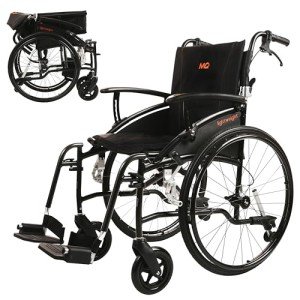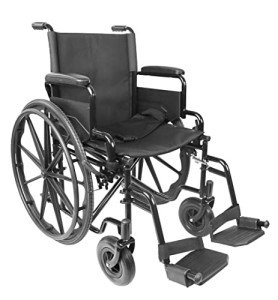Types of self Control wheelchair Control Wheelchairs
Many people with disabilities use self control wheelchairs to get around. These chairs are perfect for everyday mobility, and they are able to climb hills and other obstacles. They also have large rear shock-absorbing nylon tires that are flat-free.
 The speed of translation of wheelchairs was calculated using the local field potential method. Each feature vector was fed into an Gaussian decoder, which produced a discrete probability distribution. The accumulated evidence was used to control the visual feedback, and a command was delivered when the threshold was attained.
The speed of translation of wheelchairs was calculated using the local field potential method. Each feature vector was fed into an Gaussian decoder, which produced a discrete probability distribution. The accumulated evidence was used to control the visual feedback, and a command was delivered when the threshold was attained.
Wheelchairs with hand-rims
The type of wheel a wheelchair uses can affect its ability to maneuver and navigate different terrains. Wheels with hand-rims reduce wrist strain and increase comfort for the user. Wheel rims for wheelchairs may be made from aluminum, steel, or plastic and come in different sizes. They can be coated with vinyl or rubber to provide better grip. Some are ergonomically designed with features such as shapes that fit the grip of the user's closed and wide surfaces to allow for full-hand contact. This allows them to distribute pressure more evenly, and also prevents the fingertip from pressing.
A recent study found that flexible hand rims reduce impact forces as well as wrist and finger flexor activity during wheelchair propulsion. They also provide a larger gripping surface than tubular rims that are standard, allowing the user to use less force, while still maintaining good push-rim stability and control. They are available at a wide range of online retailers as well as DME suppliers.
The study found that 90% of the respondents were happy with the rims. It is important to note that this was an email survey of those who purchased hand rims at Three Rivers Holdings, and not all wheelchair users suffering from SCI. The survey did not measure any actual changes in the level of pain or other symptoms. It simply measured whether people perceived a difference.
Four different models are available: the light, medium and big. The light is round rim that has smaller diameter, and the oval-shaped medium and large are also available. The rims on the prime are a little bigger in diameter and feature an ergonomically shaped gripping surface. all terrain self propelled wheelchair of these rims can be placed on the front of the wheelchair and can be purchased in various shades, from naturalthe light tan color -to flashy blue, pink, red, green, or jet black. These rims are quick-release, and are easily removed to clean or maintain. In addition, the rims are coated with a protective vinyl or rubber coating that can protect the hands from sliding across the rims and causing discomfort.
Wheelchairs with tongue drive
Researchers at Georgia Tech developed a system that allows users of a wheelchair to control other electronic devices and control them by moving their tongues. It consists of a small magnetic tongue stud that transmits movement signals to a headset containing wireless sensors and the mobile phone. The smartphone then converts the signals into commands that can be used to control the wheelchair or any other device. The prototype was tested with healthy people and spinal injury patients in clinical trials.
To evaluate the effectiveness of this system, a group of physically able people used it to complete tasks that measured input speed and accuracy. Fittslaw was employed to complete tasks such as mouse and keyboard use, and maze navigation using both the TDS joystick and standard joystick. A red emergency stop button was integrated into the prototype, and a companion accompanied participants to press the button if needed. The TDS worked as well as a standard joystick.
In a separate test in another test, the TDS was compared with the sip and puff system. This lets people with tetraplegia control their electric wheelchairs by blowing or sucking into straws. The TDS completed tasks three times faster, and with greater accuracy, as compared to the sip-and-puff method. In fact, the TDS was able to operate wheelchairs more precisely than even a person suffering from tetraplegia that controls their chair with a specially designed joystick.
The TDS was able to determine tongue position with a precision of less than one millimeter. It also included cameras that could record the movements of an individual's eyes to identify and interpret their motions. Safety features for software were also implemented, which checked for valid inputs from users 20 times per second. If a valid user input for UI direction control was not received for a period of 100 milliseconds, interface modules automatically stopped the wheelchair.
The next step for the team is testing the TDS for people with severe disabilities. They are partnering with the Shepherd Center located in Atlanta, a hospital for catastrophic care, and the Christopher and Dana Reeve Foundation to conduct the tests. They plan to improve the system's ability to adapt to ambient lighting conditions and include additional camera systems, and allow repositioning to accommodate different seating positions.
Wheelchairs with joysticks
A power wheelchair equipped with a joystick allows clients to control their mobility device without having to rely on their arms. It can be mounted in the middle of the drive unit or either side. It also comes with a display to show information to the user. Some screens are large and are backlit to provide better visibility. Some screens are small and may have images or symbols that could help the user. The joystick can be adjusted to fit different sizes of hands and grips, as well as the distance of the buttons from the center.
As power wheelchair technology has evolved and improved, clinicians have been able design and create alternative driver controls to enable patients to maximize their potential for functional improvement. These innovations allow them to do this in a way that is comfortable for end users.
For example, a standard joystick is an input device that utilizes the amount of deflection in its gimble to provide an output that increases as you exert force. This is similar to the way video game controllers or accelerator pedals in cars work. However this system requires motor function, proprioception, and finger strength to be used effectively.
A tongue drive system is a different kind of control that makes use of the position of a user's mouth to determine which direction to steer. A tongue stud with magnetic properties transmits this information to the headset, which can execute up to six commands. It can be used by people with tetraplegia and quadriplegia.
Certain alternative controls are simpler to use than the standard joystick. This is especially beneficial for those with weak strength or finger movement. Others can even be operated with just one finger, which makes them ideal for those who can't use their hands in any way or have very little movement in them.
In addition, some control systems have multiple profiles which can be adapted to each client's needs. This is essential for those who are new to the system and may require adjustments to their settings frequently when they feel fatigued or experience a flare-up in an illness. This is beneficial for those who are experienced and want to change the settings set for a particular area or activity.
Wheelchairs with steering wheels
self propelled wheelchair-propelled wheelchairs are designed for people who require to maneuver themselves along flat surfaces and up small hills. They have large wheels on the rear for the user's grip to propel themselves. Hand rims allow the user to utilize their upper body strength and mobility to guide the wheelchair forward or backward. self control wheelchair-propelled chairs can be outfitted with a variety of accessories including seatbelts and armrests that drop down. They may also have legrests that can swing away. Some models can be converted into Attendant Controlled Wheelchairs, which allow caregivers and family to drive and control wheelchairs for those who require assistance.
To determine the kinematic parameters, participants' wheelchairs were fitted with three sensors that tracked movement throughout an entire week. The distances tracked by the wheel were measured using the gyroscopic sensor that was mounted on the frame as well as the one mounted on wheels. To distinguish between straight forward movements and turns, the time intervals where the velocities of the right and left wheels differed by less than 0.05 m/s were considered to be straight. Turns were then investigated in the remaining segments, and the turning angles and radii were calculated based on the wheeled path that was reconstructed.
A total of 14 participants participated in this study. They were tested for navigation accuracy and command latency. They were asked to maneuver the wheelchair through four different wayspoints in an ecological field. During the navigation trials sensors monitored the movement of the wheelchair along the entire course. Each trial was repeated twice. After each trial participants were asked how to use a self propelled wheelchair pick the direction in which the wheelchair could move.
 The results revealed that the majority participants were able to complete the navigation tasks, although they did not always follow the right directions. On the average 47% of turns were correctly completed. The other 23% were either stopped immediately after the turn, or redirected into a subsequent turning, or replaced with another straight movement. These results are similar to those of previous research.
The results revealed that the majority participants were able to complete the navigation tasks, although they did not always follow the right directions. On the average 47% of turns were correctly completed. The other 23% were either stopped immediately after the turn, or redirected into a subsequent turning, or replaced with another straight movement. These results are similar to those of previous research.




